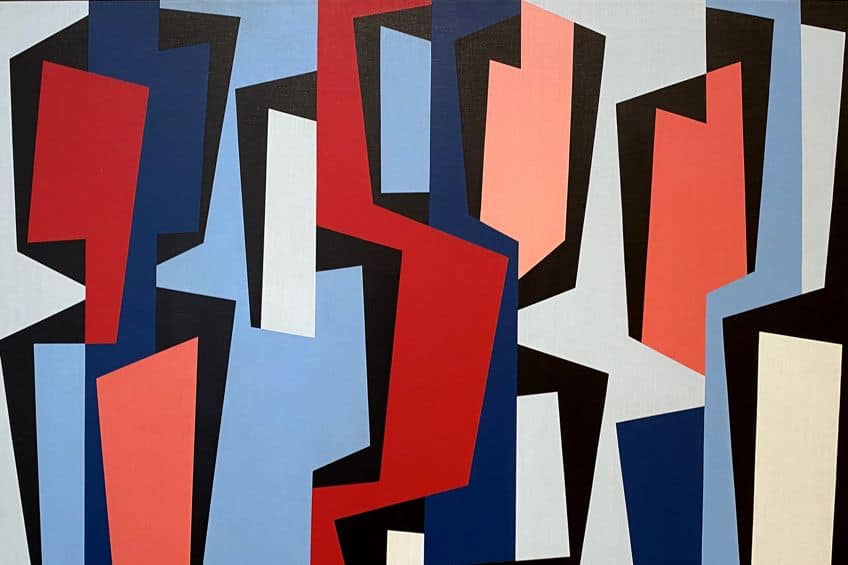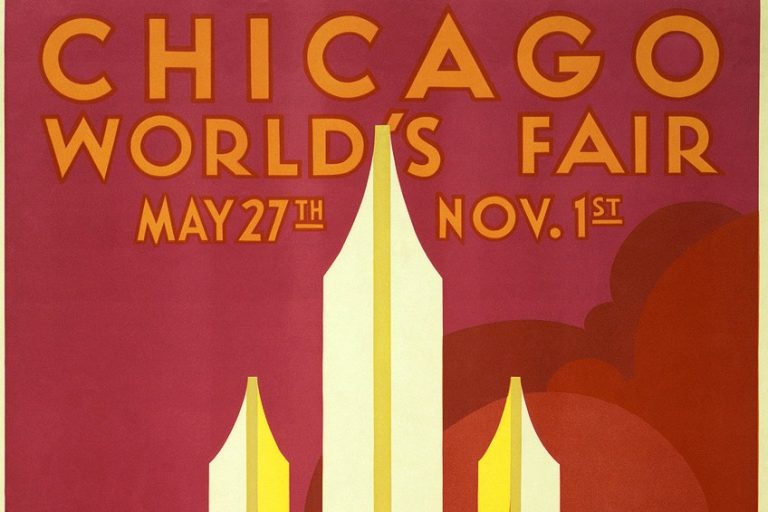Hard Edge Painting – Creating Visual Simplicity and Clarity
Hard-edge painting, an influential art movement that emerged in the 1950s and 1960s, is characterized by its crisp, clean lines and sharp color contrasts. This style of painting marked a departure from the gestural brushstrokes of Abstract Expressionism, embracing a more controlled and precise approach to composition. Artists associated with hard-edge painting, such as Ellsworth Kelly, Frank Stella, and Al Held, utilized geometric shapes and flat planes of color to create a sense of clarity and order. The movement is often seen as a reaction against the emotional intensity of previous art styles, favoring a cooler, more detached aesthetic that emphasized the formal elements of art—line, color, and shape—over narrative or symbolism. Through its emphasis on simplicity and visual clarity, hard-edge painting has had a lasting impact on contemporary art, influencing various other movements and continuing to inspire artists today.
Key Takeaways
- Hard edge painting features flat color areas with sharp edges.
- Jules Langsner coined the term in 1959 to describe California painters.
- It remains influential among contemporary artists.
History and Origins of Hard Edge Painting
| Date Movement Started | 1950s |
|---|---|
| Date Movement Ended | 1960s |
| Prominent Members | Ellsworth Kelly, Frank Stella, Al Held, and John McLaughlin |
| Style of Work | Use of abstract and geometric shape, flat colors, and clear-cut shapes |
Hard edge painting is a distinctive style of abstract painting that gained traction in the 1960s. Marked by the use of flat color areas and sharp, clean edges, this art form was a clear departure from the emotional intensity of Abstract Expressionism. This painting style is defined by its deliberate, impersonal application of paint, which creates striking contrast and clarity.
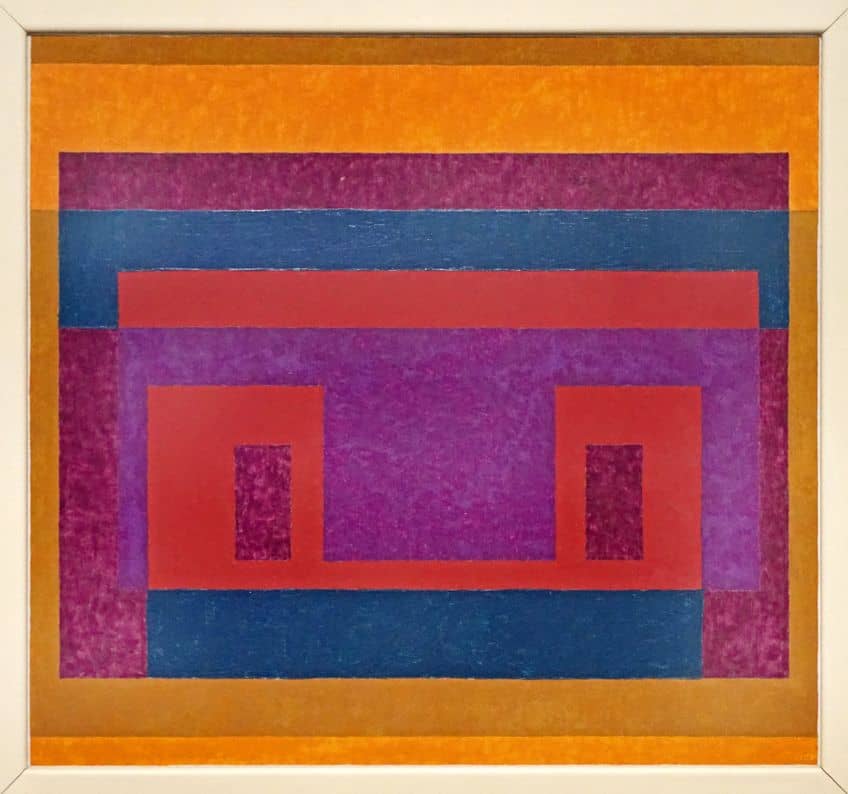
The term “Hard-edge painting” was coined by Jules Langsner in 1959. Pioneers like Karl Benjamin, Frederick Hammersley, and Frank Stella embraced geometric forms and intense colors to make bold visual statements. Their work often emphasized precision and simplicity, becoming a hallmark of the post-painterly abstraction era. This movement has continued to influence contemporary artists, proving that its clear-cut approach remains relevant. By focusing on defined shapes and vibrant colors, Hard Edge Painting has left a lasting legacy in the world of modern art.
Conceptual Emergence in Abstract Art
Hard-edge painting is largely defined by its use of sharp lines, clear shapes, and vibrant, flat colors. This style rose as artists sought a new approach to abstraction, moving away from the emotive brushstrokes of Abstract Expressionism. It favored clean boundaries and a more impersonal application of paint. In focusing on geometric shapes, these artists highlighted order and structure.
This method aimed to strip away any sense of personalization, concentrating purely on form and color, hence adding a new dimension to abstract art.
Influence of Abstract Expressionism
Abstract Expressionism, with its emphasis on spontaneous, gestural brushstrokes, set the stage for hard edge painting to develop as a counter-movement. Artists felt a need to break away from the chaotic and emotional intensity that characterized Abstract Expressionism. The methodical application and clear designs in hard edge painting represented a marked shift. While Abstract Expressionism emphasized individual freedom, hard edge painting promoted precision and control, creating a stark contrast between these two influential art movements.
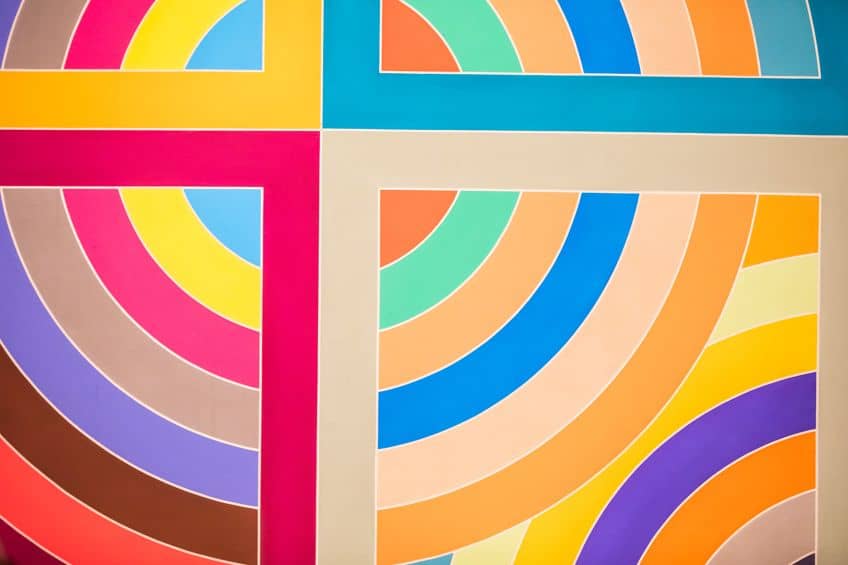
Jules Langsner and the Four Abstract Classicists
Californian critic Jules Langsner was pivotal in naming and defining hard edge painting. In 1959, he coined the term while describing works by artists who exhibited these new abstract styles. Langsner focused particularly on artists from the West Coast of the United States. Langsner’s term became widely recognized through the 1959 exhibition “Four Abstract Classicists” in Los Angeles. The exhibition featured artists Karl Benjamin, Lorser Feitelson, Frederick Hammersley, and John McLaughlin.
These artists, known as the Four Abstract Classicists, exemplified the clear-cut, geometric style of hard edge painting, lending significant credibility and recognition to this art movement.
Key Elements of Hard Edge Painting
hard edge painting combines defined geometric forms with bold colors, focusing on precision and simplicity. It often features sharp lines, clear color boundaries, and minimalistic design.
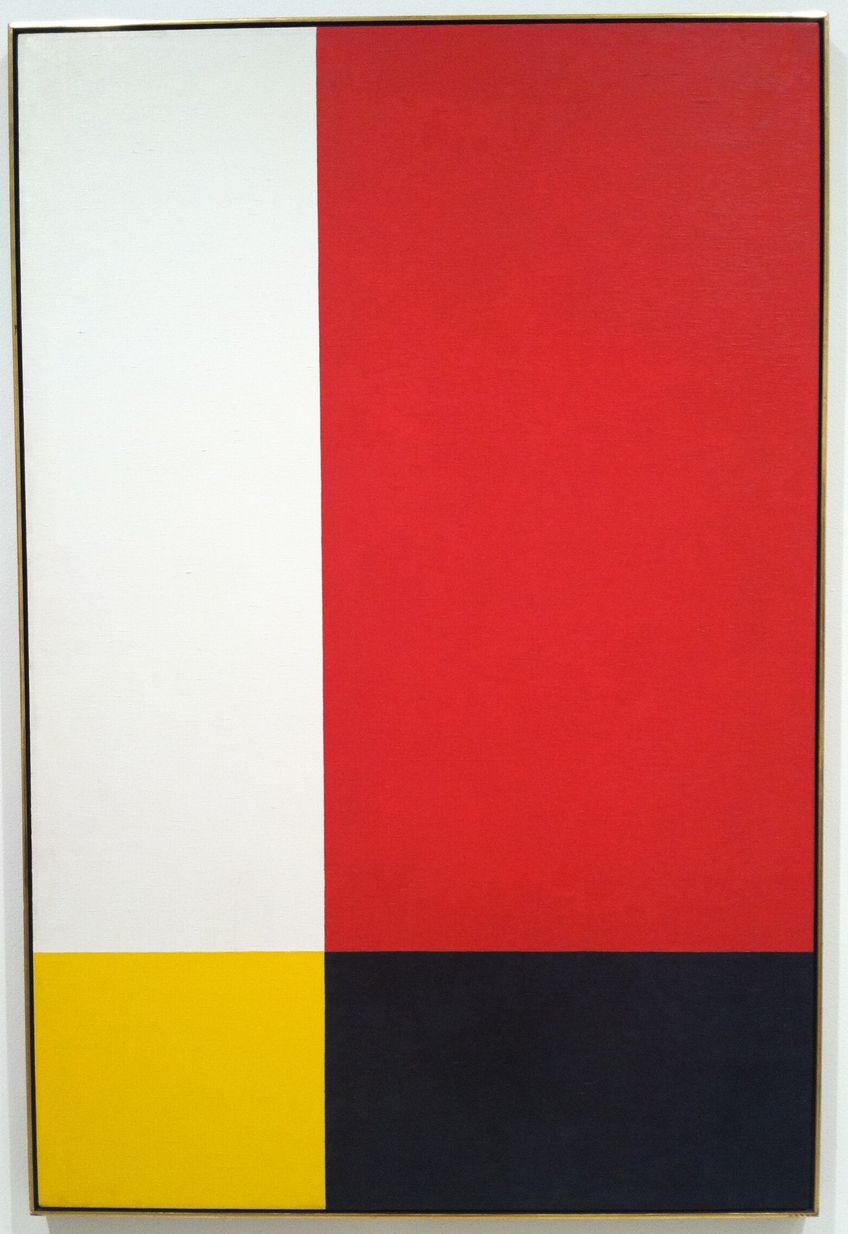
Defining Characteristics
hard edge painting is known for its geometric forms. These shapes are often simple, such as rectangles and circles, and emphasize clear, sharp lines. Artists use these forms to create an orderly and structured appearance. The color in hard edge painting is typically bold and intense. Artists choose colors for their visual impact, filling areas with fullness of color. There are often large monochromatic fields where a single color dominates. Another key trait is the economy of form.
This means artists use minimal elements to achieve maximum effect. The focus is on creating clear and uncluttered compositions.
Techniques and Medium
In hard edge painting, paint application is carefully controlled. Artists avoid visible brushstrokes, aiming for smooth surfaces. They use methods that keep the paint layer even and flat on the canvas. Techniques such as masking tape help create delineated areas with sharp boundaries. This method ensures cleanliness in the lines and keeps the sections of color distinct. The flat surface is crucial. Artists work to remove any texture from the canvas, making it appear flat and smooth. This enhances the visual simplicity and clarity of the artwork.
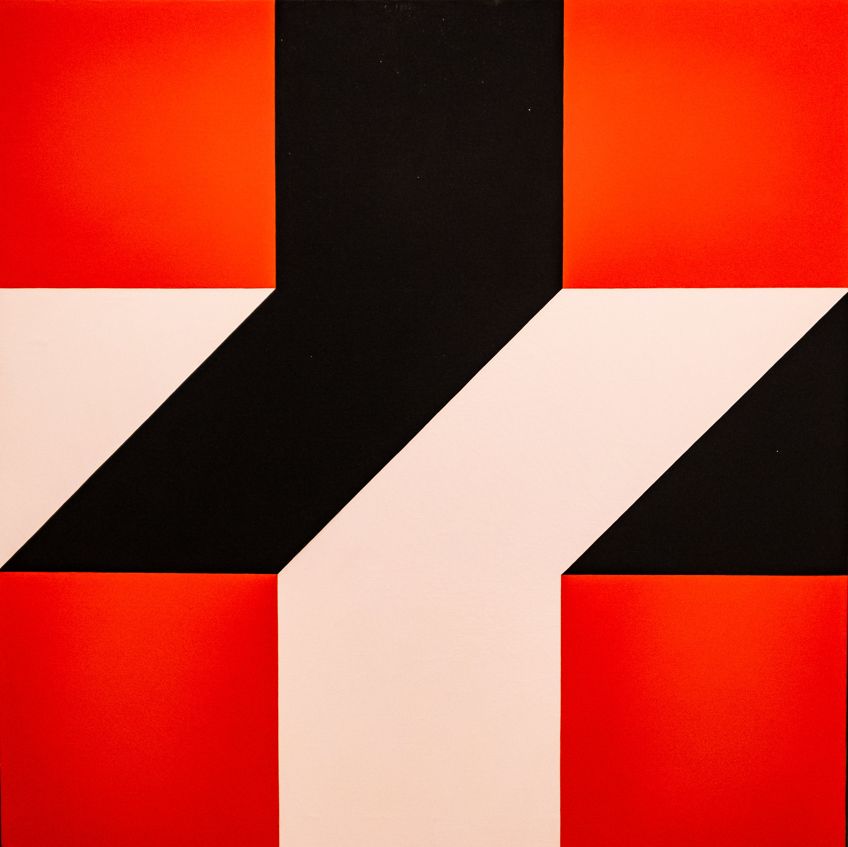
Prominent Artists and Contributions
hard edge painting emerged with a focus on geometric shapes, bright colors, and precise lines. Many artists were pioneers in developing this aesthetic, while others further expanded its possibilities. Ellsworth Kelly was known for his bold use of color and clean lines. His works often featured simple shapes in bright hues, making him a key figure in hard-edge painting. John McLaughlin emphasized simplicity and clarity. His minimalist approach often used black and white to create a stark contrast in his geometric pieces. Lorser Feitelson combined surrealism with hard-edge painting. He was integral in shaping the early movement in California.
Frederick Hammersley utilized vibrant colors and intricate patterns. His works emphasized precision and balance, contributing significantly to the movement.
Expanding the Hard Edge Aesthetic
Frank Stella brought a new dimension to hard edge painting with his elaborate patterns and forms. His works often displayed a complex arrangement of shapes and colors. Karl Benjamin was known for his colorful compositions. His artworks featured a variety of geometric shapes in harmonious color schemes. Josef Albers explored color theory through his hard-edge works. His Homage to the Square series exemplifies his focus on how colors interact.

Kenneth Noland was a central figure in Color Field painting which overlapped with hard-edge painting. His use of concentric circles and chevrons showcased vibrant color patterns. Al Held contributed through his large-scale, abstract compositions. His pieces were marked by a precise delineation of form and color. Ad Reinhardt maintained a focused, minimalist style. His work often featured large, monochromatic areas, emphasizing texture and depth. These artists pushed the boundaries of hard-edge painting, influencing future generations and other art movements.
They each brought unique perspectives and techniques, enriching the aesthetic and its varying expressions.
Hard Edge Painting in Contemporary Context
hard edge painting continues to impact the art world today, particularly influencing Minimalism and Post-Painterly Abstraction. Its influence can be seen in modern art exhibitions, galleries, and various forms of contemporary art.
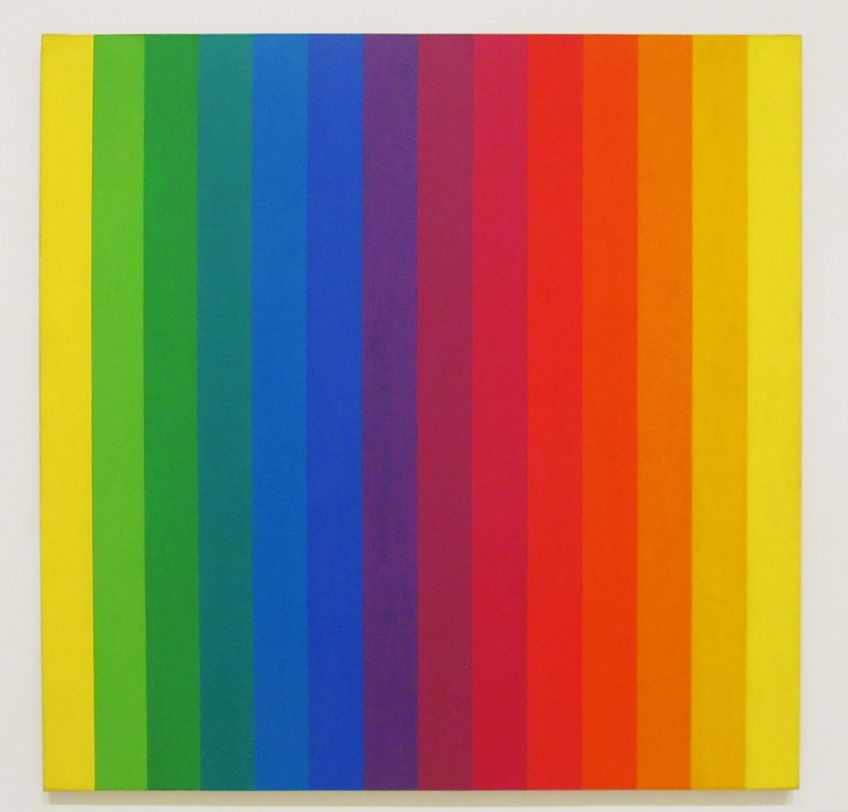
Influence on Minimalism and Post-Painterly Abstraction
hard edge painting’s emphasis on clean lines and solid colors has deeply influenced Minimalism. Artists began focusing on simplicity, using geometric shapes and avoiding intricate designs. Fields of single colors that are crisply separated are a hallmark shared by hard edge painting and Color Field painting. This simplification of form is evident in works by contemporary artists who build on principles set during the late 1950s and 1960s.
Post-Painterly Abstraction also draws from hard edge painting, prioritizing flatness and clarity. The West Coast art scene, including galleries like the Pavilion Gallery and Ferus Gallery, played significant roles in spreading these styles. Their exhibitions often featured works that displayed the transitions from Hard Edge to Post-Painterly approaches.
Modern Manifestations and Exhibitions
In today’s art world, hard edge painting influences various mediums beyond traditional canvases. Installations and video art exhibit flat planes of vivid colors and sharp edges, a nod to hard edge principles. Contemporary galleries, such as NoHo Modern and the Ben Maltz Gallery at Otis Art Institute, showcase exhibitions where Hard Edge influences are evident.

For example, recent exhibitions have highlighted the clean, hard lines characteristic of Hard Edge Art, reinterpreted with modern contexts. The Esther Robles Gallery and Heritage Gallery of Los Angeles have also continued to support this art form, featuring artists who borrow from the Hard Edge aesthetic. These venues maintain the style’s relevance by juxtaposing it with other contemporary movements like Op Art and fine arts that prioritize precision.
Hard-edge painting represents a pivotal chapter in the evolution of modern art, emphasizing precision, clarity, and the intrinsic beauty of geometric forms. By stripping away the emotional and gestural elements prevalent in earlier movements, hard-edge painters introduced a new visual language that celebrated simplicity and formalism. This movement not only provided a counterpoint to Abstract Expressionism but also paved the way for subsequent developments in minimalism and conceptual art. Today, the influence of hard-edge painting endures, as contemporary artists continue to explore and reinterpret its principles, underscoring its continuing legacy in the broader narrative of art history.
Frequently Asked Questions
Who Are Some Notable Artists Associated With the Hard-Edge Painting Movement?
Ellsworth Kelly is well-known for his use of clear, bright colors and simple, hard-edged shapes. Frank Stella often used straight lines and bold, geometric patterns in his works. Karl Benjamin contributed significantly with his vibrant and structured compositions.
What Are Some Distinctive Characteristics of Hard-Edge Painting?
Hard-edge paintings feature sharp, clear lines that separate areas of color. The colors used are often bold and bright, creating strong visual contrasts. The paintings usually have a flat, smooth surface with little visible brushwork.
How Did the Hard-Edge Painting Movement Evolve and Influence the Art World?
The term hard-edge painting was first used in 1959 by critic Jules Langsner. This movement emerged as a response to the more expressive styles of abstract expressionism. It has influenced various artistic styles, including minimalism and contemporary graphic design.
How Can the Concept of Hard-Edge Be Distinguished from Soft-Edge in Painting?
Hard-edge painting involves sharp, crisp lines between areas of color. Soft-edge painting features gradual transitions and blends between colors. Hard-edge creates a more geometric and controlled look, while soft-edge often appears more natural and blended.
Isabella studied at the University of Cape Town in South Africa and graduated with a Bachelor of Arts majoring in English Literature & Language and Psychology. Throughout her undergraduate years, she took Art History as an additional subject and absolutely loved it. Building on from her art history knowledge that began in high school, art has always been a particular area of fascination for her. From learning about artworks previously unknown to her, or sharpening her existing understanding of specific works, the ability to continue learning within this interesting sphere excites her greatly.
Her focal points of interest in art history encompass profiling specific artists and art movements, as it is these areas where she is able to really dig deep into the rich narrative of the art world. Additionally, she particularly enjoys exploring the different artistic styles of the 20th century, as well as the important impact that female artists have had on the development of art history.
Learn more about Isabella Meyer and the Art in Context Team.
Cite this Article
Isabella, Meyer, “Hard Edge Painting – Creating Visual Simplicity and Clarity.” Art in Context. July 11, 2024. URL: https://artincontext.org/hard-edge-painting/
Meyer, I. (2024, 11 July). Hard Edge Painting – Creating Visual Simplicity and Clarity. Art in Context. https://artincontext.org/hard-edge-painting/
Meyer, Isabella. “Hard Edge Painting – Creating Visual Simplicity and Clarity.” Art in Context, July 11, 2024. https://artincontext.org/hard-edge-painting/.


